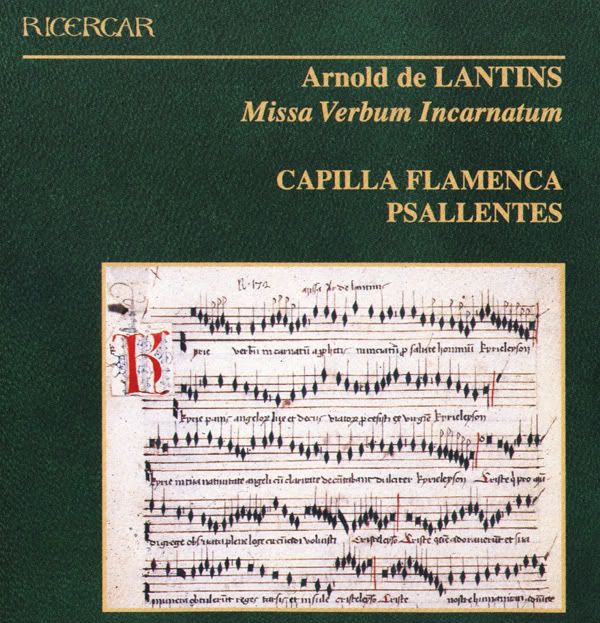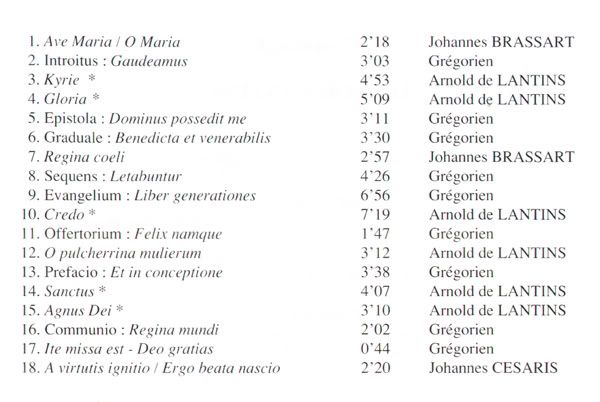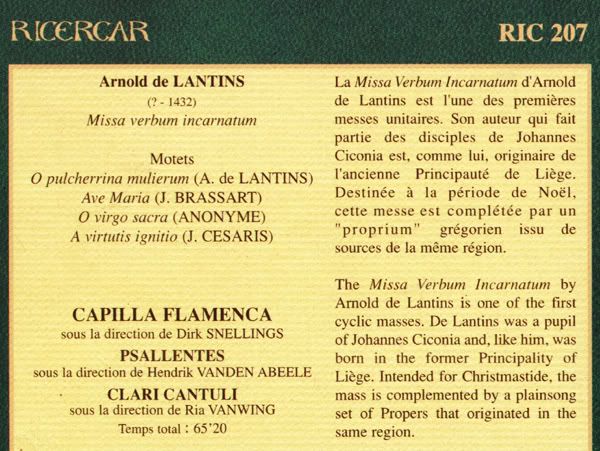Pro Member
Group: Members
Posts: 695
Warn:0%
|
 |
|
Arnold de Lantins (d.1432)Missa Verbum IncarnatumLabel: Ricercar, 207 Year: 2002 Performers:Capilla Flamenca Psallentes Clari Cantuli Dirk Snellings - direction of Capilla Flamenca Hendrik Vanden Abeele - direction of Psallentes Ria Vanwing - direction of Clari Cantuli Tracklist:01. Brassart: Ave Maria / O Maria 02. Chant: Introitus - Gaudeamus 03. Lantins: Kyrie "Verbum Incarnatum" 04. Lantins: Gloria "Verbum Incarnatum" 05. Chant: Epistola - Dominus possedit me 06. Chant: Graduale - Benedicta et venerabilis 07. Brassart: Regina coeli 08. Chant: Sequens - Letabuntur 09. Chant: Evangelium - Liber generationes 10. Lantins: Credo "Verbum Incarnatum" 11. Chant: Offertorium - Felix namque 12. Lantins: O pulcherrina mulierum 13. Chant: Prefacio - Et in conceptione 14. Lantins: Sanctus "Verbum Incarnatum" 15. Lantins: Agnus Dei "Verbum Incarnatum" 16. Chant: Communio - Regina mundi 17. Chant: Ite missa est - Deo gratias 18. Cesaris: A virtuitis ignitio / Ergo beata nascio Arnold de Lantins (d.1432) is one of the group of prominent composers of the early 1400s to be associated with Liege. He may have been a student of Ciconia, and is generally believed to have been the brother of Hugo de Lantins (fl.1420-30), although there is no clear documentation on either point.In 1970, I had records of only the most familiar 15th-century composers when I ventured into the realm of forgotten names and bought Kees Otten’s disc (Electrola 1C 063-24011) containing this Mass by Arnold de Lantins along with an instrumental motet by Hugo de Lantins and six works of Dufay. The Mass is found in the celebrated manuscript Bologna Q15, dating to the 1420s, so it would be an early example of the Mass cycle, further indicated by its three-voice texture. This is the first recording of the Mass since that premiere, and it is part of a complete Mass that includes chant Propers as well as epistle, gospel, and preface. Brassart and Cesaris are added as bookends, with another Brassart motet after the gradual and Lantins’s motet after the offertory. This last work fits well here, because each movement of the Mass refers to it. The only reason for the name that has been given to the Mass (rather than "Missa O pulcherrima") is the insertion of the trope "Verbum incarnatum" in the Kyrie.
As expected, Otten’s heavy instrumental accompaniment has yielded to a discreet use of a pair of trumpets, but otherwise there is a similarity of tempos and other aspects of the two performances. Where Otten used solo voices on the two upper parts, Snellings uses three voices to a part, still using the instruments on the lowest line. The new version does use period-specific pronunciation. The more obvious difference between the two discs is situating the Mass movements within the liturgical framework. Clari Cantuli is a small children’s choir that sings the chant propers in octaves with the men, using contemporary chant editions.
The three composers all came from the territory of Liege, a large area centered in what is now eastern Belgium that was governed by the bishop (as were many other ecclesiastical principalities, most famously Salzburg), so the whole production focuses on the musical traditions of that area. Arnold, as we know, ended his days in Rome as a member of the papal chapel with Dufay in 1431, and his death the following year is indicated by someone else’s applying for his ecclesiastical benefice (a position that supplied income). This disc is a valuable addition to the many liturgical reconstructions that give us a close look at a specific time and place in the medieval and Renaissance eras. It may be noted that an anonymous motet, O virgo sacra, is listed on the cover but not performed, apparently replaced by the second Brassart motet. Well worth searching out.   | SPOILER (LOG FILE) | Exact Audio Copy V1.0 beta 1 from 15. November 2010
EAC extraction logfile from 21. April 2011, 16:17
Capilla Flamenca, Clari Cantuli, Psallentes / Arnold de Lantins - Missa verbum incarnatum
Used drive : HL-DT-STDVDRAM GSA-H62N Adapter: 2 ID: 1
Read mode : Secure
Utilize accurate stream : Yes
Defeat audio cache : Yes
Make use of C2 pointers : No
Read offset correction : 667
Overread into Lead-In and Lead-Out : No
Fill up missing offset samples with silence : Yes
Delete leading and trailing silent blocks : No
Null samples used in CRC calculations : Yes
Used interface : Installed external ASPI interface
Gap handling : Appended to previous track
Used output format : User Defined Encoder
Selected bitrate : 256 kBit/s
Quality : High
Add ID3 tag : No
Command line compressor : C:\Program Files\Exact Audio Copy\Flac\flac.exe
Additional command line options : -8 -V -T "ARTIST=%a" -T "TITLE=%t" -T "ALBUM=%g" -T "DATE=%y" -T "TRACKNUMBER=%n" -T "TOTALTRACKS=%x" -T "GENRE=%m" -T "ALBUMARTIST=%v" -T "ALBUM ARTIST=%v" -T "COMMENT=EAC Secure Mode, Test & Copy, AccurateRip, FLAC -8" %s
TOC of the extracted CD
Track | Start | Length | Start sector | End sector
---------------------------------------------------------
1 | 0:00.00 | 2:18.06 | 0 | 10355
2 | 2:18.06 | 3:32.57 | 10356 | 26312
3 | 5:50.63 | 4:53.62 | 26313 | 48349
4 | 10:44.50 | 5:14.06 | 48350 | 71905
5 | 15:58.56 | 3:09.68 | 71906 | 86148
6 | 19:08.49 | 3:30.67 | 86149 | 101965
7 | 22:39.41 | 2:57.48 | 101966 | 115288
8 | 25:37.14 | 4:26.63 | 115289 | 135301
9 | 30:04.02 | 6:58.60 | 135302 | 166711
10 | 37:02.62 | 7:19.50 | 166712 | 199686
11 | 44:22.37 | 1:47.31 | 199687 | 207742
12 | 46:09.68 | 3:11.44 | 207743 | 222111
13 | 49:21.37 | 3:39.50 | 222112 | 238586
14 | 53:01.12 | 4:07.40 | 238587 | 257151
15 | 57:08.52 | 3:11.66 | 257152 | 271542
16 | 60:20.43 | 2:03.38 | 271543 | 280805
17 | 62:24.06 | 0:44.49 | 280806 | 284154
18 | 63:08.55 | 2:20.20 | 284155 | 294674
Track 1
Filename G:\A\Arnold de Lantins - Missa verbum incarnatum (2002) [FLAC]\01 - Ave Maria Gratia Plena.wav
Pre-gap length 0:00:02.00
Peak level 49.2 %
Extraction speed 2.5 X
Track quality 100.0 %
Test CRC AE8C346A
Copy CRC AE8C346A
Track not present in AccurateRip database
Copy OK
Track 2
Filename G:\A\Arnold de Lantins - Missa verbum incarnatum (2002) [FLAC]\02 - Gregorian Chant - Gaudeamus.wav
Peak level 44.3 %
Extraction speed 2.8 X
Track quality 100.0 %
Test CRC 856FD75F
Copy CRC 856FD75F
Track not present in AccurateRip database
Copy OK
Track 3
Filename G:\A\Arnold de Lantins - Missa verbum incarnatum (2002) [FLAC]\03 - Kyrie.wav
Peak level 68.8 %
Extraction speed 3.0 X
Track quality 100.0 %
Test CRC 0D6A33DB
Copy CRC 0D6A33DB
Track not present in AccurateRip database
Copy OK
Track 4
Filename G:\A\Arnold de Lantins - Missa verbum incarnatum (2002) [FLAC]\04 - Gloria.wav
Peak level 93.2 %
Extraction speed 3.0 X
Track quality 100.0 %
Test CRC 4B9E5046
Copy CRC 4B9E5046
Track not present in AccurateRip database
Copy OK
Track 5
Filename G:\A\Arnold de Lantins - Missa verbum incarnatum (2002) [FLAC]\05 - Gregorian Chant - Epistola. Dominus possedit me.wav
Peak level 15.4 %
Extraction speed 2.3 X
Track quality 99.9 %
Test CRC A43F9D5C
Copy CRC A43F9D5C
Track not present in AccurateRip database
Copy OK
Track 6
Filename G:\A\Arnold de Lantins - Missa verbum incarnatum (2002) [FLAC]\06 - Gregorian Chant - Benedicta et venerabilis es.wav
Peak level 25.6 %
Extraction speed 2.9 X
Track quality 100.0 %
Test CRC 26347DF7
Copy CRC 26347DF7
Track not present in AccurateRip database
Copy OK
Track 7
Filename G:\A\Arnold de Lantins - Missa verbum incarnatum (2002) [FLAC]\07 - Regina coeli.wav
Peak level 77.4 %
Extraction speed 2.3 X
Track quality 99.9 %
Test CRC D7DC3788
Copy CRC D7DC3788
Track not present in AccurateRip database
Copy OK
Track 8
Filename G:\A\Arnold de Lantins - Missa verbum incarnatum (2002) [FLAC]\08 - Gregorian Chant - Letabuntur.wav
Peak level 54.8 %
Extraction speed 2.9 X
Track quality 100.0 %
Test CRC 318791C7
Copy CRC 318791C7
Track not present in AccurateRip database
Copy OK
Track 9
Filename G:\A\Arnold de Lantins - Missa verbum incarnatum (2002) [FLAC]\09 - Gregorian Chant - Liber generacionis.wav
Peak level 46.9 %
Extraction speed 3.1 X
Track quality 100.0 %
Test CRC B591DC63
Copy CRC B591DC63
Track not present in AccurateRip database
Copy OK
Track 10
Filename G:\A\Arnold de Lantins - Missa verbum incarnatum (2002) [FLAC]\10 - Credo.wav
Peak level 83.2 %
Extraction speed 2.9 X
Track quality 99.9 %
Test CRC 7B17DBF2
Copy CRC 7B17DBF2
Track not present in AccurateRip database
Copy OK
Track 11
Filename G:\A\Arnold de Lantins - Missa verbum incarnatum (2002) [FLAC]\11 - Gregorian Chant - Felix namque.wav
Peak level 16.3 %
Extraction speed 2.4 X
Track quality 100.0 %
Test CRC 3368B5AF
Copy CRC 3368B5AF
Track not present in AccurateRip database
Copy OK
Track 12
Filename G:\A\Arnold de Lantins - Missa verbum incarnatum (2002) [FLAC]\12 - O pulcherrina mulierum.wav
Pre-gap length 0:00:00.01
Peak level 54.7 %
Extraction speed 2.3 X
Track quality 99.9 %
Test CRC B1654B12
Copy CRC B1654B12
Track not present in AccurateRip database
Copy OK
Track 13
Filename G:\A\Arnold de Lantins - Missa verbum incarnatum (2002) [FLAC]\13 - Gregorian Chant - Et in conceptione.wav
Peak level 20.5 %
Extraction speed 2.8 X
Track quality 100.0 %
Test CRC E34703E5
Copy CRC E34703E5
Track not present in AccurateRip database
Copy OK
Track 14
Filename G:\A\Arnold de Lantins - Missa verbum incarnatum (2002) [FLAC]\14 - Sanctus.wav
Peak level 89.0 %
Extraction speed 2.9 X
Track quality 100.0 %
Test CRC 65E6C755
Copy CRC 65E6C755
Track not present in AccurateRip database
Copy OK
Track 15
Filename G:\A\Arnold de Lantins - Missa verbum incarnatum (2002) [FLAC]\15 - Agnus Dei.wav
Peak level 76.7 %
Extraction speed 2.8 X
Track quality 100.0 %
Test CRC 42098C19
Copy CRC 42098C19
Track not present in AccurateRip database
Copy OK
Track 16
Filename G:\A\Arnold de Lantins - Missa verbum incarnatum (2002) [FLAC]\16 - Gregorian Chant - Regina mundi.wav
Peak level 38.3 %
Extraction speed 2.0 X
Track quality 99.9 %
Test CRC 5A3AA283
Copy CRC 5A3AA283
Track not present in AccurateRip database
Copy OK
Track 17
Filename G:\A\Arnold de Lantins - Missa verbum incarnatum (2002) [FLAC]\17 - Gregorian Chant - Ite missa est.wav
Peak level 19.8 %
Extraction speed 1.8 X
Track quality 100.0 %
Test CRC 17642550
Copy CRC 17642550
Track not present in AccurateRip database
Copy OK
Track 18
Filename G:\A\Arnold de Lantins - Missa verbum incarnatum (2002) [FLAC]\18 - A virtutis ignitio - Ergo beata nascio.wav
Peak level 73.9 %
Extraction speed 2.6 X
Track quality 100.0 %
Test CRC B76BD10E
Copy CRC B76BD10E
Track not present in AccurateRip database
Copy OK
None of the tracks are present in the AccurateRip database
No errors occurred
End of status report
==== Log checksum 2E3BB337F6C37C128F97AF1E92B98D55599AE37C350D5D01B01EA4AF4C23370C ==== |
This post has been edited by kgkk on 18-05-2011, 21:43 |

 Help
Help
 Search
Search
 Members
Members
 Gallery
Gallery
 Calendar
Calendar






